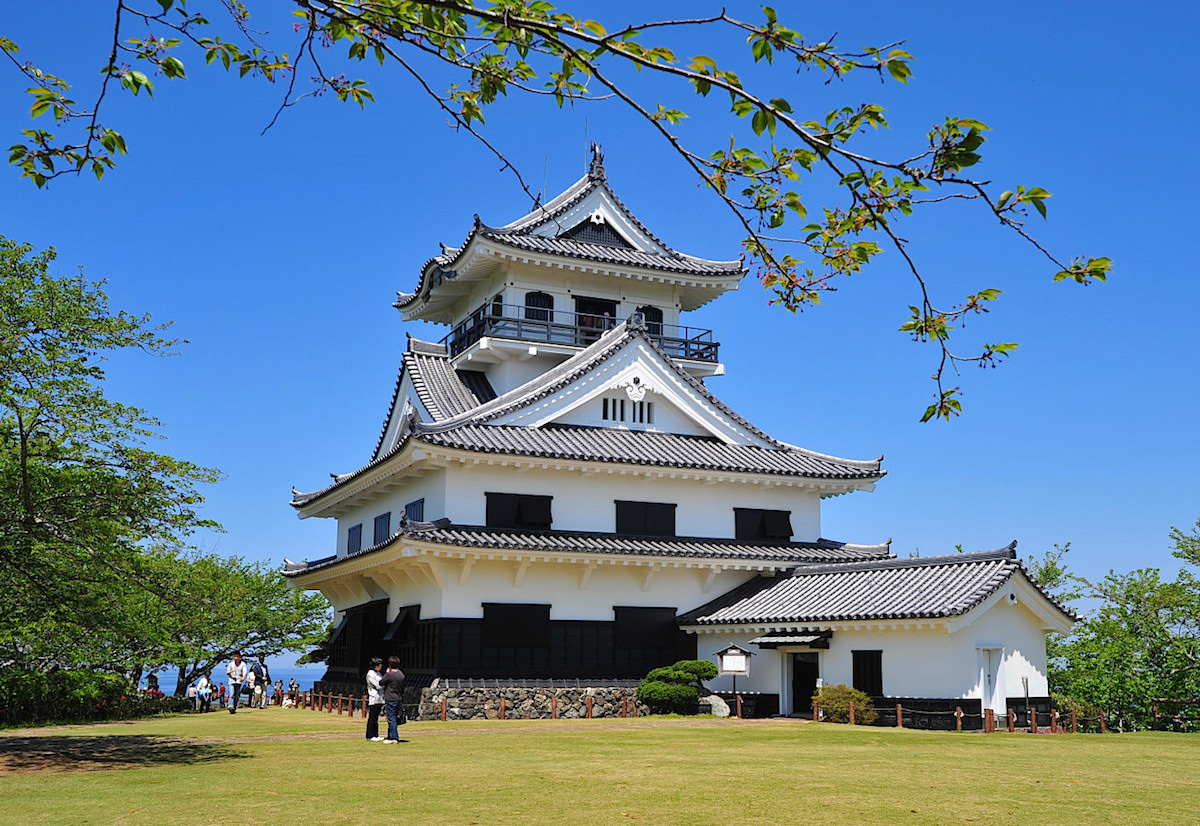館山市街の南に位置する標高65mほどの丘陵は、1580(天正8)年、里見義頼(さとみよしより)が築いた館山城跡。城跡一帯は「日本の歴史公園100選」にも選定される城山公園として整備され、城山山頂には、模擬天守が建てられています。内部は『南総里見八犬伝』の資料などを展示の館山市立博物館分館(八犬伝博物館)となっています。


館山市街の南に位置する標高65mほどの丘陵は、1580(天正8)年、里見義頼(さとみよしより)が築いた館山城跡。城跡一帯は「日本の歴史公園100選」にも選定される城山公園として整備され、城山山頂には、模擬天守が建てられています。内部は『南総里見八犬伝』の資料などを展示の館山市立博物館分館(八犬伝博物館)となっています。
安房の国の神々を集めて祀った総社。平安時代の初め、安房国総社として国府のあった国府村(現・南房総市府中)に創建され、鎌倉時代に源氏の氏神である八幡宮に変わり現社地に遷座しています。源頼朝が安房国で再起の際には、この社に武運長久祈念し、源実朝(みなもとのさねとも=頼朝の四男・鎌倉3代将軍)が社殿を造営と伝えられています。
南房総・館山市の知る人ぞ知るご利益スポットが、常楽山萬徳寺。境内に安置された全長16m、重さ30tの巨大な釈迦涅槃仏(しゃかねはんぶつ)は、大願成就、また足腰の弱い人にご利益があるといわれています。仏教の修業を重ねた尼僧が仏の受記を得て発願から22年の歳月を経て昭和57年に完成したもの。
千葉県館山市の那古にある奈良時代創建という古刹。『那古寺縁起』によれば、717(養老元)年に行基(ぎょうき)が創建したと伝えられる真言宗智山派の寺です。かつては源頼朝、足利氏、里見氏らの信仰を集め、源頼朝が本尊の千手観音に帰依して七堂伽藍を建立。江戸時代には、鶴岡八幡宮の別当を兼ねて隆盛しました。
館山湾を見下ろす、堂山(107.5m)中腹の崖に建つ大福寺は、真言宗智山派の古刹。717(養老1)年に行基が東国行脚の折、地元漁民の海上安全と豊漁を祈願して、岩肌の自然石に十一観世音菩薩を彫刻し開山と伝えられます。県内最古といわれる十一面観世音菩薩の磨崖仏(岩肌を彫った仏像)が祀られていることから「崖の観音」の別名も。
房総半島最南端、太平洋に突き出ている南房総市白浜町の台地に建つ灯台。灯火部分に上ることの可能な参観灯台で、狭く急な階段を上れば太平洋と、南房総国定公園に指定された南房総の岩礁地帯を一望に。観音埼灯台についで古い灯台で「日本の灯台50選」に選定されるほか、国の登録有形文化財にもなっています。「灯台資料展示館」を併設。
前回に引き続き、一般社団法人プレスマンユニオンのご案内で千葉県鴨川市を取材した際のことをつづります。2日目(2月26日)に訪れた「みんなみの里〜鴨川市総合交流ターミナル〜」での食用菜花(ナバナ)摘みは、3月上旬までだそうなので、急ぎ書きたいと思います!
I visited Kamogawa City, Chiba Prefecture, on a press tour during the weekend of February 25-26. On the second day, we went to Minnami no Sato, where we got to handpick edible canola flowers. Please note that this activity is only available until the beginning of March — hence why I’ve made this blog entry now!
JR安房鴨川駅下車、日東バス東京湾フェリーあるいは平塚本郷行きで「みんなみの里」バス停下車。あるいは鴨川駅よりタクシーで約20分。
(Approx. 20 minutes on taxi from JR Kamogawa Station)
TEL:04-7099-8055
Website:https://www.muji.com/jp/shop/046602
2月25、26日に、一般社団法人プレスマンユニオンのご案内で千葉県鴨川市を取材しました。2日目に訪れた「菜な畑ロード」の菜の花摘み体験期間が3月12日(日)までなので、まずはこちらからご紹介しようと思います。
I visited Kamogawa City, Chiba Prefecture, on the weekend of February 25-26. I’ll start out by writing about Nanabatake Road, where you get to handpick canola flowers until Sunday, March 12. Canola flower is also known as rapeseed or rape blossoms, but I’m going to avoid using these terms for obvious reasons.
菜な畑ロードで摘めるのは観賞用の菜の花
(Canola flowers at Nanabatake Road are not edible)
菜の花には食用のほか、観賞用と菜種油用があり、菜な畑ロードで摘めるのはすべて観賞用です。上の写真からもわかるように、背丈がだいぶ高く、大人の腰のあたりまで伸びています。
There are different types of canola flowers — some are edible, while others are only for enjoying through your eyes, or for extracting canola oil. Here at Nanabatake Road, you get to handpick the kind that you put in a vase and enjoy its lovely sight. As you can see from the picture above, these flowers are quite tall, reaching the height of an adult’s hip.
お値段は、ひとり10本150円。長靴とハサミを無料で貸してくれるので、特に何も持参しなくてもOKですよ。もちろん、子どもサイズの長靴も完備。ただ、花粉症の方はマスクが必須です。
The cost is 150 yen/ten stalks. They rent out rubber boots (of course, there’s children’s size too) and scissors for free, so there really isn’t anything you need to bring. If you’re allergic to pollen though, be sure to put on masks.
I saw many couples while I was there. There were families too, which grandparents, parents and children all busy at choosing which stalks to cut and take home. But it might be wise to watch out for honey bees — there were quite a lot of them flying around, pollinating flowers.
遮断機の音も本格的でした。もちろん、踏切はなかったけれど。
Event the sound of the crossing gate was real. Of course, there weren’t any railroad crossing.
日本さくらの会から「日本さくら名所100選」の地に選定される泉自然公園(千葉市若葉区)には、ソメイヨシノ(240本)、ヤマザクラ(860本)、オオシマザクラ(240本)、サトザクラ(90本)など、20種1500本の桜が植栽されています。
北総台地がつくりだす起伏に富んだ地形を活かした千葉市の風致公園。千葉都心部から東南11kmほどの場所に位置し、面積42.5haという広大な公園です。桜と紅葉の名所でもあり、ヤマザクラを中心とする桜は「日本さくら名所100選」にも選定されています。公園の大半が東千葉近郊緑地特別保全地区に指定され、貴重な自然が保たれています。
千葉県富津市の内裏塚古墳群にある前方後円墳。墳丘長は106mで、稲荷山古墳と並んで内裏塚古墳群のなかでは3番目の規模を誇る大きな古墳です。周濠を含めると全長126mと推定されています。青堀小学校近くにありながら、こんもりとした古墳の雰囲気を残しながら、多くの謎を秘めた古墳になっています。
千葉県富津市にある墳丘長122mという巨大な前方後円墳。内裏塚古墳群(だいりづかこふんぐん)のなかで、内裏塚古墳に次ぐ大きな古墳で、周囲に二重の周濠を巡らせ、周濠部を含めた全長は193mにも達します。江戸時代には三条塚古墳を取り込むように飯野藩の藩庁である飯野陣屋が築かれています。
飯野陣屋(いいのじんや)は、江戸時代、上総国(かずさのくに)周淮郡(すえぐん)飯野(現・千葉県富津市下飯野)にあった飯野藩の藩庁。飯野陣屋のは藩主・保科家とその家臣たちの屋敷がありました。「日本三大陣屋」の一つに数えられ、三大陣屋のなかではもっとも往時の雰囲気を残した陣屋です。
墳丘長27mで、内裏塚古墳群では三番目の規模を誇る方墳。残念ながら周辺の開発で墳丘は大きく削られてしまっています。昭和58に発掘調査が行なわれ、須恵器や土師器とともに石室内に安置された木棺に使用されたと推測される鉄釘が出土しています。横穴式石室は砂岩切石積みでつくられ全長6.9mです。
内裏塚古墳群のひとつに数えられる前方後円墳。墳長106m、後円部径52m、前方部幅84mで6世紀の築造と推定されています。周囲を後円部分でで22m、前方部分でで17m幅の濠が巡らされています。調査によってさらに外側にも全長202mの濠があったことが確認されています。周溝を含めた規模では、内裏塚古墳群中最大の古墳です。
千葉県富津市の内裏塚古墳群のひとつ。墳丘長103m(後円部直径57m、前方部幅74m)で、内裏塚古墳群では五番目の墳丘長を誇る大きな古墳です。内裏塚古墳、稲荷山古墳、三条塚古墳と並んで、須恵国造(すえのくにのみやつこ)など古代の地域の盟主の古墳だと推測されています。
千葉県富津市にある墳丘長144mの前方後円墳で千葉県最大の古墳。関東地方でも第8位、千葉県内や房総半島、東京湾周辺では最大規模を誇る巨大古墳となっています。前方後円墳11基、方墳7基、円墳29基が確認されている内裏塚古墳群の中心的な墳墓です。
富津市の青堀駅前のロータリー横にある古墳が上野塚古墳(うわのつかこふん)。前方後円墳11基、方墳7基、円墳29基の計47基の古墳が確認される内裏塚古墳群(だいりづかこふんぐん)の1基で、帆立貝型の前方後円墳。5世紀末頃築造で、内裏塚古墳群のなかでは最北、もっとも海岸線近くに位置しています。